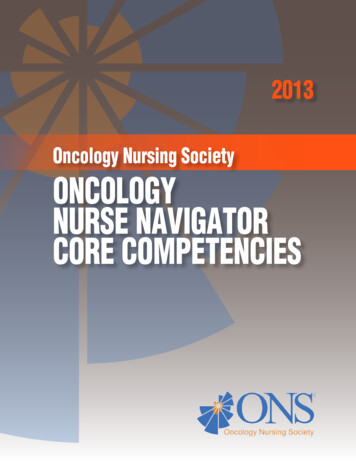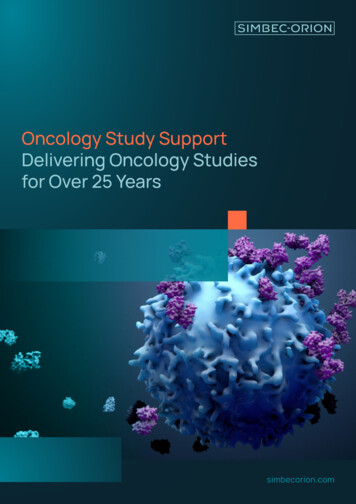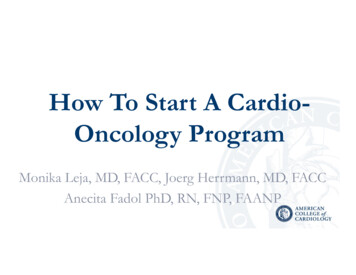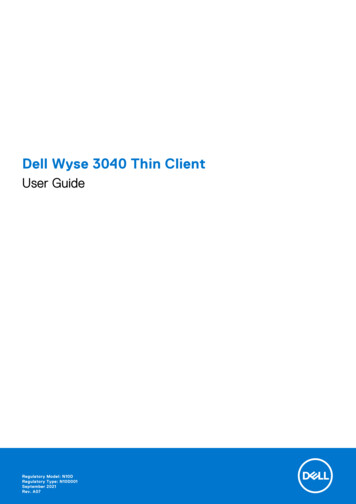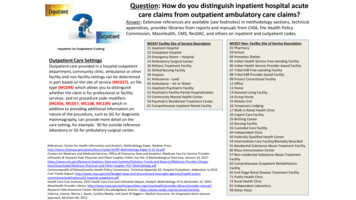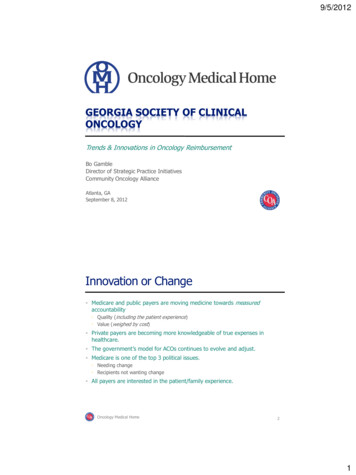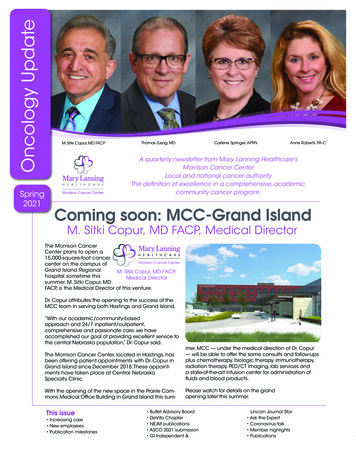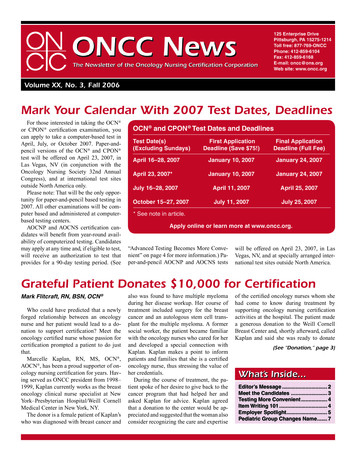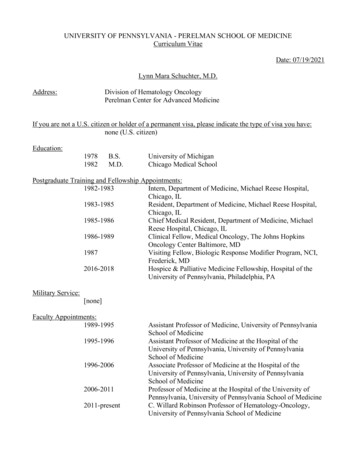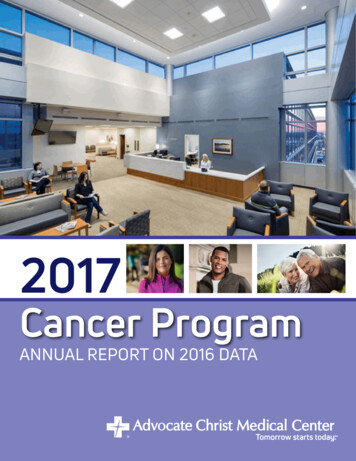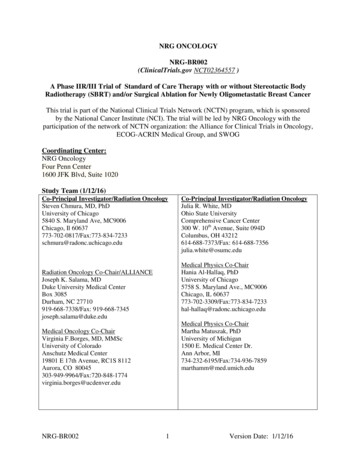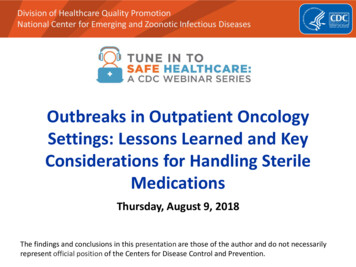
Transcription
Division of Healthcare Quality PromotionNational Center for Emerging and Zoonotic Infectious DiseasesOutbreaks in Outpatient OncologySettings: Lessons Learned and KeyConsiderations for Handling SterileMedicationsThursday, August 9, 2018The findings and conclusions in this presentation are those of the author and do not necessarilyrepresent official position of the Centers for Disease Control and Prevention.
Program ObjectivesPROGRAM DESCRIPTION: This webinar will discuss infectious outbreaks in outpatient oncology settingsthat have been linked to breaches in safe injection practices and sterilecompounding standards. Key considerations for safe handling of sterilemedications during compounding and administration will also be discussed.OBJECTIVES: Identify unsafe injection and compounding practices that have been linked tohealthcare-associated infection (HAI) outbreaks in outpatient oncology andother clinic settings. Identify the minimum standards for safe injection practices and whenstandards for sterile compounding are applicable. Describe the importance of early recognition and notification of potential HAIoutbreaks to public health authorities.2
SpeakersNadine Shehab, PharmD, MPHSenior Scientist, Division of Healthcare Quality Promotion, CDCLisa Richardson, MD, MPHDirector, Division of Cancer Prevention and Control, CDCJoseph W. Coyne, RPhDirector of Field Operations, Clinical IQ LLCMartha Polovich, PhD, RN, AOCNAssistant Professor, Georgia State University College of Nursingand Health Professions3
Outpatient Oncology Settings areImportant for Ensuring Patient Access toCare 1.7 million people are diagnosed with cancer each year 1 million cancer patients receive outpatientchemotherapy or radiation Outpatient oncology settings provide several benefits:– avoid hospitalization and costs of inpatient stays,– treatment administered at patient convenience, familiarfacility,– drug administration under close supervision of oncologist.4
Infection Prevention in Oncology Settingsis Critical for Patient Safety Attention to infection prevention in oncology settings isespecially important due to patients’ heightened risk ofinfection:– underlying malignancy and chemotherapy,– frequent contact with healthcare settings,– placement of indwelling intravascular access devices orundergo surgical procedures. Many outpatient oncology facilities lack infection controlpolicies and procedures to ensure patient protection5
Outbreaks in Outpatient Oncology ClinicsLinked to Sterile Compounding andUnsafe Injection Practices6
Infection Prevention in Oncology Settingsis Critical for Patient SafetyIt is important for outpatient oncology settings to: Recognize that failure to adhere to safe injection practicesand sterile compounding standards places patients at riskfor healthcare-associated infections (HAIs) and other adverseevents Become familiar and implement standards for basic infectioncontrol and safe injection practices Know when medication preparation practices are subject tosterile compounding standards and apply the appropriatestandards for those practices Identify and report suspected HAI outbreaks to public healthauthorities as soon as they are identified7
Two Concepts Addressed Throughout Sterile compounding (focus of today’s presentation) Safe injection practices8
What are Safe Injection Practices? Set of measures taken to perform injections in an optimally safemanner for patients, healthcare personnel, and others Part of CDC’s Standard Precautions, reflect minimumstandards that healthcare personnel should follow toprevent transmission of infections in healthcare settings Never administer medications from the same syringe to more than one patient, even if theneedle is changed or you are injecting through an intervening length of IV tubing. Do not enter a medication vial, bag, or bottle with a used syringe or needle. Never use medications packaged as single-dose or single-use for more than one patient. This includes ampoules, bags, and bottles of intravenous solutions.Always use aseptic technique when preparing and administering injections.Failure to adhere to Standard Precautions, including safe injectionpractices, has resulted in serious patient harm, includingdisease transmission and patient notifications.Standard Precautions for All Patient Care ard-precautions.html)FAQs regarding Safe Practices for Medical Injections vider faqs.html)9
What is Drug Compounding?Definition“Compounding is generally a practice in which a licensed pharmacist, [or] a licensedphysician combines, mixes, or alters ingredients of a drug to create a medicationtailored to the needs of an individual patient.” ** Human Drug ault.htm)Compounding Standards (http://www.usp.org/compounding)Laws,Standards &Guidance Oversight &Enforcement Federal Food, Drug, and Cosmetic Act (Sections 503A and 503B)FDA guidance (e.g., Insanitary Conditions)Individual state pharmacy practice lawsMinimum practice standards: USP General Chapter 795 Pharmaceutical Compounding—Non-sterilePreparations USP General Chapter 797 Pharmaceutical Compounding—Sterile Preparations USP General Chapter 800 Hazardous Drugs—Handling in Healthcare SettingsPrimarily: FDA, state boards of pharmacyAccreditors, certifiers also play a roleFailure to adhere to laws and minimum standards applicable to sterile compounding inhealthcare settings (pharmacies, hospitals, and clinics) has resulted in serious patient harm,including disease transmission and patient notifications10
Sterile Drug Compounding – Examples Preparing multiple chemotherapy infusion bags foradministration later in the day Combining multiple medications (e.g., antibiotics,heparin) in a saline bag Re-packaging contents of a saline or heparin bag intomultiple syringes11
Outbreaks linked to Compounded Drugsfrom Pharmacy Settings12
CDC and State Health Departments AreIncreasingly Responding to Outbreaks inOutpatient SettingsOutbreaks and Patient Notifications in Outpatient Settings, Selected Examples, ent/outbreaks-patient-notifications.html)13
Outbreaks in Outpatient Settings(Selected Examples)Where Are Outbreaks Occurring? Ambulatory SurgicalCenters (ASCs)Chiropractic clinicsCosmetic surgery clinicsDental / oral surgeryclinicsOrthopedic clinics Oncology clinicsPain managementclinicsPhysician officesPlastic surgery centersRadiology clinicsRheumatology clinicsUrology clinicsOutbreaks and Patient Notifications in Outpatient Settings, Selected Examples, ent/outbreaks-patient-notifications.html)14
Outbreaks in Outpatient SettingsWhy Are Outbreaks Occurring? Shift in healthcare delivery from inpatient settings tooutpatient settings Breaches in sterile compounding and safe injectionpractices identified in outpatient settingsConsequences: Infection transmission to patients Notification of thousands of patients of possible exposure tobloodborne pathogens Disciplinary action, referral of providers to licensing boards Malpractice suits filed by patients15
Outbreaks in Outpatient SettingsWhat are the Medication Handling Breaches?Medication Administration(Unsafe injection practices)Medication Preparation(Unsafe compounding practices) Failure to follow aseptic practices (incl. proper handhygiene)Insanitary medicationpreparation areasUntrained/non-qualifiedpersonnel performing sterilecompoundingAbsence of proper controls(e.g., ISO-class 5 hoods)Improper storage and labelingof sterile medication vials Reuse of syringes for 1 patientReuse of syringes to accessmedication vials for 1 patientReuse of single-dose vials andsaline bags for 1 patientFailure to wear facemaskswhen performing spinalinjectionsSuboptimal procedures for IVline access and maintenanceOutbreaks and Patient Notifications in Outpatient Settings, Selected Examples, ent/outbreaks-patient-notifications.html)16
Outbreaks in Oncology Settings (Examples)Year(State)Pathogen(s)Infection(s),No. of ons,N 102011(MS)Pseudomonasaeruginosa andKlebsiellapneumoniaeBloodstreaminfections,N ,N 15Infection Control and Sterile CompoundingBreachesLack of adherence to sterile compounding standardsin preparing chemotherapy and other medications(e.g., breaches in aseptic technique)Common needle and syringe to access multiple multidose vialsAbe K, et al.ICHE2007;28:131113 Syringe reuse among patientsReuse of syringes to access medication containersused for 1 patientDobbs TE, et al.AJIC2014;42:731-4 Lack of adherence to sterile compounding standardsin preparing chemotherapy and repackaging sterilemedicationsUse of common-source bag of saline to prepare salineflushSuboptimal procedures for central line accessSee I, et al. ICHE2014;35:300-6 Lack of adherence to sterile compounding standardsin preparing chemotherapy and other medications(e.g., breaches in aseptic technique, hoods locatednext to sinks)Yablon BR, et al.ICHE2017;38:314-9 Lack of adherence to safe injection practicesLack of adherence to sterile compounding standardsin preparing chemotherapy and other medications(e.g., breaches in aseptic technique, hoods locatednext to sinks)Vasquez AM, etal. MMWR2016;65:1274-5 tions,N 12ExophialadermatitidisBloodstreaminfections,N 17Reference17
Outbreak of Tsukamurella BloodstreamInfections, Oncology Clinic, West Virginia, 2011Sterile compoundinghood adjacent toopen windowCompounding hood disinfectedwith alcohol of insufficientstrengthMedication preparationadjacent to sinkSee I, et al. Infect Control Hosp Epidemiol 2014;35(3):300-6.18
Outbreak of Pantoea BloodstreamInfections, Oncology Clinic, Illinois, 2012Medication preparationadjacent to sinkBreaches in aseptichandling of sterilemedicationsInfusion productsadjacent to sinkYablon BR, et al. Infect Control Hosp Epidemiol 2017;38(3):3014-9.19
Outbreak of Exophiala Bloodstream Infections,Oncology Clinic, New York, 2016Exposure of critical sterilesites of hood to potentiallycontaminated materialsVaquez AM, et al. MMWR 2016;65(45):1274-5.Medications improperlystored and labeled, withvisible signs ofcontamination20
Outpatient Settings Present UniqueChallenges for Oversight and Prevention Lack of oversight and accreditation of outpatientsettings relative to inpatient settings– No clearly established authority for monitoring adherenceto infection control and sterile compounding standards inthese settings*—state public health departments, boardsof medicine, boards of pharmacy, federal authorities?*CMS-certified facilities receive some oversight in adherence to infection control practices, but only aminority of outpatient facilities are certified. Lack of infrastructure and resources to supportinfection control and sterile compounding– Sterile compounding is conducted in the absence ofpharmacy controls and by inadequately trained personnel21
Outpatient Settings Present UniqueChallenges for Oversight and Prevention Highly variable requirements for provider training,licensure, certification, and continuing education– Physicians and allied health professionals may be unawarethat the practices they engage in are subject to federaland state sterile compounding laws / standards Highly variable requirements for monitoring andreporting of HAIs and other adverse events to stateand federal authorities– Delayed identification of and response to outbreaks,potentially leading to large patient notifications / harm22
Infection Prevention in Oncology Settingsis Critical for Patient SafetyIt is important for outpatient oncology settings to: Recognize that failure to adhere to safe injection practicesand sterile compounding standards places patients at riskfor healthcare-associated infections (HAIs) and other adverseevents Become familiar and implement standards for basic infectioncontrol and safe injection practices Know when medication preparation practices are subject tosterile compounding standards and apply the appropriatestandards for those practices Identify and report suspected HAI outbreaks to public healthauthorities as soon as they are identified23
Key Facility and Personnel Requirementsfor Handling Sterile & Hazardous DrugsJoseph W. Coyne RPhDirector of Field OperationsClinical IQ, LLCCopyright 2008-2017 ClinicalIQ, LLC - All Rights Reserved
Acknowledgements Many of the slides presented in this program come fromthe CriticalPoint Live Training/Educational Series. Thanks to Kate Douglass, Eric Kastango and Jim Wagnerfor their expertise in putting together the content. Permission to use the copyrighted slides/images andmaterials are provided by CriticalPoint, LLC. Use of this educational material by a 3rd party does notconstitute endorsement by, CriticalPoint or ClinicalIQ
What Practice Standards Exist? American Society of Health-System Pharmacists (ASHP)– 1983 - First Hazardous Drug Technical Advisory Bulletin (TAB)– 2006 - Current version of ASHP Guidelines on HandlingHazardous Drugs (new version coming soon) Oncology Nursing Society (ONS)– Founded in 1975– 2018 - Safe Handling of Hazardous Drugs, 3rd edition American Society of Clinical Oncology (ASCO) / ONS– 2009 - Chemotherapy Administration Safety Standards (now2016 course update)ASHP Guidelines on Handling Hazardous Drugs [PDF - 34 pages] Toolkit for Safe Handling of Hazardous Drugs for Nurses in Oncology g-hazardousdrugs-nurses-oncology)Safe Handling of Hazardous Drugs Third Edition -drugs-third-edition)
What Regulations Exist? USP 795 PharmaceuticalCompounding – NonsterilePreparations USP 797 PharmaceuticalCompounding – SterilePreparations OSHA regulations CMS Hospital Conditions ofParticipation State regulationsCompounding Standards (http://www.usp.org/compounding)Revised Hospital Guidance for Pharmaceutical Services and Expanded Guidance Related to Compounding of Medications [PDF - 45 ous Drugs ml)
Identification of Issues Recognition that there is nofederal standard that protectsworkers from hazardous drug (HD)exposure Professional organizationalguidance documents are notregulations USP is recognized in the federalFood, Drug, and Cosmetic Act toset drug standards USP chapters numbered under 1000 are federally-enforceablestandards
USP Chapter 797 Scope Describes the minimum standards to prevent harm, includingdeath, from:– microbial contamination (nonsterility),– excessive bacterial endotoxins,– variability in strength of correct ingredients,– chemical and physical contaminants,– ingredients of inappropriate quality in compounded sterile preparations (CSPs). Applies to:– all persons who prepare compounded sterile preparations– all places where CSPs are prepared– pre-administration manipulations of CSPs including storage, compounding, and transport Does not apply to administration! Specific chapter language:– “shall” is a requirement (must)– “should” is a recommendation
USP Chapter 800 Scope Promotes patient safety, worker safety, and environmentalprotection. Handling hazardous drugs (HDs) includes, but is notlimited to: receipt, storage, compounding, dispensing, administration,disposal Applies to all healthcare personnel who handle HD preparationsand all entities which store, prepare, transport, or administer HDs(e.g., pharmacies, hospitals and other healthcare institutions,patient treatment clinics, physicians' practice facilities, orveterinarians' offices). Personnel who may potentially be exposed to HDs include, butare not limited to: pharmacists, pharmacy technicians, nurses,physicians, physician assistants, home healthcare workers,veterinarians, and veterinary technicians.
General Facility Elements Ceiling – epoxy-coated gypsum board oranodized aluminum T grids– Tiles must be caulked in place Walls – epoxy-coated gypsum board orinterlocking panels Floors – wide-sheet vinyl or poured epoxy Sink – deep enough to perform hand hygiene tothe elbows Lighting – sealed, flush mounted, easilycleanable
Engineering Controls
Engineering Controls for Containment:DefinitionsContainment Primary Engineering Control (C-PEC) Ventilated device to minimize worker and environmentalexposure For sterile compounding, also provides product protectionContainment Secondary Engineering Control (C-SEC) The room in which the C-PEC is placedContainment Supplemental Engineering Controls Adjunct controls to offer additional levels of protection Closed System Drug-Transfer Devices (CSTDs)
Primary Engineering Controls Laminar Air Flow Workbench (LAFW) Biological Safety Cabinet (BSC) Compounding Aseptic Isolator (CAI & CACI)
Secondary Engineering Controls Secondary EngineeringControl is facility design Positive Pressure - Netdisplacement of air outof the space Negative Pressure - Netdisplacement of air intothe spaceTraditional ISO Class 7(Laminar Airflow Work hood) LAFW
Supplemental Engineering Controls These devices are adjunct controls that may be used with C-PEC or CSECs to offer additional levels of protection (containment) Facilitate enhanced occupational protection especially duringadministration Closed System Drug-Transfer Devices (CSTDs) are the only kind ofContainment Supplemental Engineering Control available at this timeRemember: CSTDs still can’t prevent damage or spills from poor handling or transport! CSTDs are intended for use in an ISO Class 5 or better environment
Use of Dispensing Devices Outside ofEngineering Controls Spiking a bag, vial, or bottle of sterile fluid with adispensing device and leaving that device in place towithdraw medication for multiple patients increases therisk for microbial contamination. When performedoutside of an ISO Class 5 environment, the device andsubsequently the fluid can become contaminated. Forthis reason, using a dispensing device to spikeparenteral solutions outside of an ISO Class 5environment and leaving it in place to dispensemedication for multiple patients puts patients at risk forinfection and must be prohibitedAPIC Position Paper: Safe Injection, Infusion, and Medication Vial Practices in Health Care (2016) [PDF - 18 pages](https://www.apic.org/Resource /TinyMceFileManager/Position Statements/2016APICSIPPositionPaper.pdf)
Cleanroom SuiteHazardous applications: Anteroom must achieve at least ISO class 7 & bepositive to uncontrolled spaces Positive to the HD compounding room
Containment SegregatedCompounding Area (C-SCA) A type of Secondary Engineering Control– Unclassified room with fixed walls dedicated to preparationof low to medium risk level HD CSPs– Defined perimeter to separate functions– Limited to 12 hour BUD (proposed 797 is 12 hour room/24hour refrigerated)– PEC must be externally vented– Minimum 12 ACPH– 0.01” w.c. to 0.03” w.c. negative pressure– Hand washing sink at least 1 meter from C-PEC Can be either inside or directly outside the C-SCAUSP General Chapter 800 Hazardous Drugs—Handling in Healthcare apter-hazardous-drugs-handling-healthcare)
Containment SegregatedCompounding Area (C-SCA) –Example
Beyond Use DatingConfigurationISO Class 7Buffer RoomC-SCAC-PECC-SECMaximumBUD Externally VentedExamples: Class II BSC CACI 30 ACPHExternally ventedNegative pressurebetween 0.01 and0.03” w.c.As described in 797 Externally VentedExamples: Class II BSC CACI 12 ACPHExternally ventedNegative pressurebetween 0.01 and0.03” w.c.12 hours
Storage and Handling
Requirements for Storing HDInventory HDs that may be storedwith other inventory:– Non-antineoplastic– Reproductive risk only– Final dosage forms Antineoplastic HDs(requiringmanipulation otherthan counting) andall HD APIs must bestored per all USPChapter 800 requirements
Storage Requirements Hazardous drugs shall be storedseparately from other inventory in amanner to prevent contamination andpersonnel exposure.–Minimum of 12 ACPH from exhaust–Negative pressure of 0.01 to 0.03”w.c.USP General Chapter 800 Hazardous Drugs—Handling in Healthcare apter-hazardous-drugs-handling-healthcare)
Personnel Training –Sterile Compounding All personnel who handle HDs must be trainedbased on their job functions Personnel competency must be reassessed at leastevery 12 months Personnel must be trained prior to the introductionof a new HD or new equipment and prior to a newor significant change in process or SOP All training and competency assessment must bedocumented
Personnel Training –Hazardous Drugs The training must include at least the following:– Overview of entity's list of HDs and their risks– Review of the entity's SOPs related to handling of HDs– Proper use of PPE– Proper use of equipment and devices (e.g., engineeringcontrols)– Response to known or suspected HD exposure– Spill management– Proper disposal of HDs and trace-contaminated materials
Thank YouJoseph W. Coyne RPhDirector of Field OperationsClinical IQ LLCOffice (224) 360-6926joe.coyne@clinicaliq.comwww.clinicaliq.com
Oncology Nursing PerspectivesMartha Polovich, PhD, RN, AOCNGeorgia State UniversityAtlanta, GA48
Preparation of Sterile Drugs Are you compounding?– Combining, mixing, or altering ingredients to createmedication to meet unique needs of an individual patient USP Chapter 797 standards for sterile compounding– Clean room conditions– Competent personnel– Monitoring the environment Immediate use sterile compounding– Emergencies ONLY– Limited number of manipulations– Only non-hazardous drugsUSP, 201249
Prevention of Infections Aseptic technique for medication preparation andadministration Minimize frequency of IV catheter manipulations Catheter care bundle to prevent CLABSI––––––Hand hygiene before insertionMaximal sterile barrier precautions for insertionCleanse insertion site with 0.5% chlorhexidine with alcoholAvoid femoral / jugular sitesRemove unnecessary catheters“Scrub the hub”Camp Sorrel & Matey, 2017; O’Grady et. al., 201150
Safe Injection Practices Perform drug preparation in a dedicated medicationpreparation area Scrub medication vial diaphragms with 70% alcoholand allow to dry Do not use single-dose vials for more than one patient Dedicate multi-dose vials to a single patient wheneverpossible Do not open syringe packages until needed Do not “batch” prepare syringes for later use outside ofcontrolled environment Use commercially manufactured or pharmacy-preparedprefilled syringes (e.g., saline & heparin)CDC, 201151
Resources from ONSToolkit for Safe Handling of Hazardous Drugs for Nurses in Oncology ghazardous-drugs-nurses-oncology)Safe Handling of Hazardous Drugs Third Edition -drugs-third-edition)52
Additional Information and Resources53
CDC Resources: Infection Control Basic Infection Control and Prevention Plan forOutpatient Oncology Settings [PDF - 32 c-infectioncontrol-prevention-plan-2011.pdf Guide to Infection Prevention for OutpatientSettings: Minimum Expectations for Safe Care Outpatient Settings Policy Options for ImprovingInfection Prevention [PDF - 37 ent-SettingsPolicy-Options.pdf Injection /provider faqs.html54
CDC Resources: Infection Control Basic Infection Control and PreventionPlan for Outpatient Oncology SettingsI.II.III.IV.Fundamental Principles of Infection PreventionEducation and TrainingSurveillance and ReportingStandard PrecautionsA. Hand HygieneB. Personal ProtectiveC. Respiratory Hygiene and Cough EtiquetteD. Injection SafetyE. Medication Storage and HandlingF.F. Cleaning and Disinfection of Devices andEnvironmental SurfacesV. Transmission-BasedVI. Central Venous CathetersBasic Infection Control and Prevention Plan for Outpatient Oncology 5
CDC Resources: Injection SafetyInjection Safety (https://www.cdc.gov/injectionsafety/)FAQs regarding Safe Practices for Medical Injections vider faqs general.html) 56
FDA & USP Resources: SterileCompounding FDA: Human Drug ult.htm USP: Compounding Standardshttp://www.usp.org/compounding57
CDC’s Preventing Infections in CancerPatients ProgramLisa C. Richardson, MD, MPHDirector, Division of Cancer Prevention and Control
Preventing Infections in Cancer Patients(PICP) ProgramThree websites forpatients, caregivers& HCPs30 Campaign MaterialsFact sheets, posters,infographics, postcards, patientcare totes, etc.59
Preventing Infections in Cancer Patients(PICP) Program 300 million potential people exposed to PICP content PICP resources have been downloaded, received, or viewedmore than 2 million times since program was launched 40% increase in PreventCancerInfections.org visitors from2016 to 2017 47% improvement in cancer patients indicating theyreceived infection prevention education from their provider 25% increase in patients and caregivers’ understanding ofneutropenia after visiting PCI.org60
What’s Next? Virtual Simulation ToolsAn interactive roleplay simulationfeaturing Tina andJoe our virtualpatient and provider61
What’s Next? Special ResourcesPreventCancerInfections.org/es Educational Materials62
ConclusionPlease preventinfectionsThe findings and conclusions in this report are those of the authors and do not necessarilyrepresent the official position of the Centers for Disease Control and Prevention.
Infection Prevention in Oncology Settingsis Critical for Patient SafetyIt is important for outpatient oncology settings to: Recognize that failure to adhere to safe injection practicesand sterile compounding standards places patients at riskfor healthcare-associated infections (HAIs) and other adverseevents Become familiar and implement standards for basic infectioncontrol and safe injection practices Know when medication preparation practices are subject tosterile compounding standards and apply the appropriatestandards for those practices Identify and report suspected HAI outbreaks to public healthauthorities as soon as they are identified64
Thank YouFor more information, contact CDC1-800-CDC-INFO (232-4636)TTY: 1-888-232-6348 www.cdc.govOutbreak inquiries and guidance:haioutbreak@cdc.govInjection safety inquires and guidance:injectionsafety@cdc.govThe findings and conclusions in this report are those of the authors and do not necessarilyrepresent the official position of the Centers for Disease Control and Prevention.
Program Objectives PROGRAM DESCRIPTION: This webinar will discuss infectious outbreaks in outpatient oncology settings that have been linked to breaches in safe injection practices and sterile compounding standards. Key considerations for safe handling of sterile medications during compounding and administration will also be discussed. OBJECTIVES:
